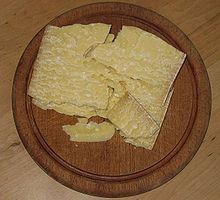Sbrinz
| Sbrinz | |
|---|---|
 | |
| Country of origin | Switzerland |
| Region | Central Switzerland |
| Texture | hard and very hard |
| Fat content | 45% |
| Aging time | 24 to 30 months |
| Certification | AOC and AOP |
Sbrinz is a very hard cheese produced in central Switzerland. It is often used instead of Parmesan cheese in Swiss cuisine. The cheese is produced in only 42 dairies in central Switzerland. Only local cow's milk is used when producing this cheese. It is kept in the region until ready for consumption. Contrary to popular belief, the name Sbrinz does not originally refer to a particular place or region.[citation needed] Nevertheless, the Swiss Cheese Union added to this myth by launching an advertising campaign in the 1990s. As a result of this campaign, there is now an area called Sbrinz.[where?]
Character[]
Sbrinz is an extra hard full fat cheese. It contains approximately 40% to 45% of fat when dry. The cheese must ripen for 16 months before it can be sold as Sbrinz, and the full flavour only develops after about 24–30 months in storage.[1]
History[]
Sbrinz is claimed to be the oldest European cheese. The Celtic ancestors of the Swiss were making cheese centuries before the birth of Christ.[2] This cheese may have been an ancestor to modern Sbrinz. The official web site claims that the cheese was first mentioned in 70 AD, but does not give any details. Other sources claim that the cheese is mentioned in contracts dated around 1200.[citation needed] It seems certain, however, that it is mentioned in documents dating from 1530, which are kept in the state archive in Bern.[3]
Starting in 2001, Sbrinz was granted an appellation d'origine contrôlée (AOC) certification. The AOC provides specifications for the origin of the milk and the processes that must be followed in order for the cheese to labeled as Sbrinz. In 2013, this was replaced by the appellation d'origine protégée (AOP) certification.
Consumption[]
Sbrinz is commonly consumed in several ways; it can be used grated, such as on pasta. It can be eaten in small pieces, often to accompany wine. It is also eaten in thin slices planed from the hard cheese. Sbrinz is often simply enjoyed with bread and butter.
See also[]
- Cheeses of Switzerland
- Bergkäse
- Culinary Heritage of Switzerland
References[]
- ^ Sbrinz in the online Culinary Heritage of Switzerland database.
- ^ Weinzweig, Art; Judy Ridgway (2004). The Cheese Companion: The Connoisseur's Guide. Running Press. p. 16. ISBN 0-7624-1956-3.
- ^ Roth, Alfred G. (1993). "Der Sbrinz" und die verwandten Bergkäse der Schweiz. Burgdorf: ED Emmentaller Druck. p. 2. OCLC 884417427. Archived from the original on 29 August 2010.
External links[]
| Wikimedia Commons has media related to Sbrinz (cheese). |
- Official page – in German, French, Italian and English.
- Sbrinz in the online Culinary Heritage of Switzerland database.
- Swiss cheeses
- Cow's-milk cheeses
- Culinary Heritage of Switzerland